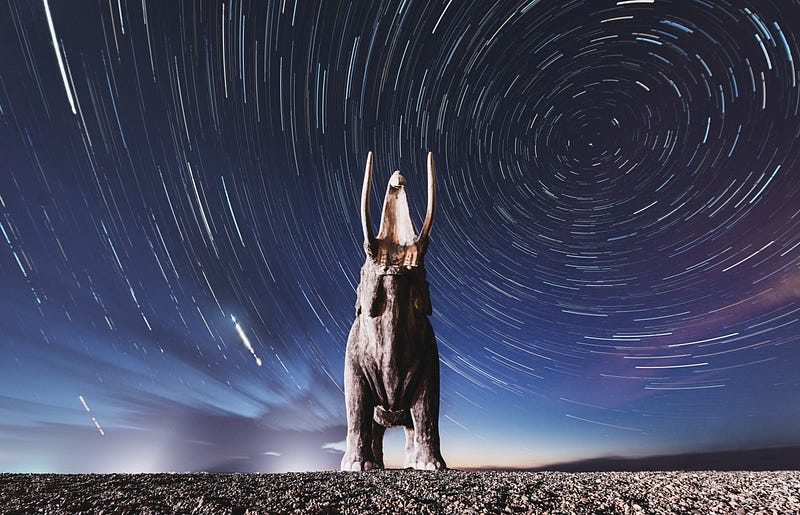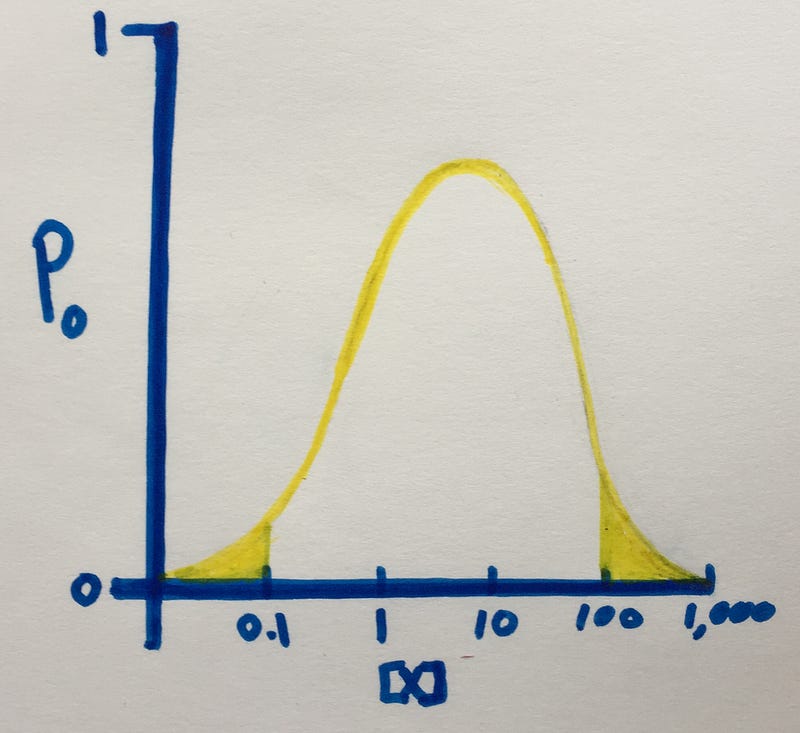Understanding Non-Human Intelligence: A New Perspective
Written on
Chapter 1: The Evolution of Intelligence
Intelligence may not be as uncommon as we tend to think.

“Mastodon in the Stars” by shaunl During a panel discussion for the Breakthrough Prize in 2019, John Hardy stated, “Once life begins, the emergence of intelligent life seems highly probable. It has developed independently on Earth multiple times.”
Research suggests that intelligence has indeed emerged several times throughout Earth's history: once in marine mammals, elephants, and primates; again in the corvid family and parrots; and yet again in cephalopods, particularly octopuses, squid, and cuttlefish.
For me, the realization that non-human animals possess intelligence was unexpected. I believe this oversight stemmed from my long-standing dietary habits and my involvement in neurobiology research that involved numerous animals. Acknowledging animal intelligence complicates the moral implications of these actions. My focus on verbal communication also led me to overlook beings with whom I could not communicate.
My perspective shifted when I stumbled upon a book titled “Are We Smart Enough to Know How Smart Animals Are?” by Frans de Waal. Although I didn’t read it immediately, the title lingered in my mind, prompting me to ponder the question.
Once I began to search for it, evidence of animal intelligence became apparent everywhere. A prime example is Jonathan Balcombe's insightful article in Nautilus, “Fish Can Be Smarter than Primates.” Shows like Planet Earth and Blue Planet illustrate numerous species using tools or collaborating towards common objectives.
How do we define and measure animal intelligence? What evolutionary factors are believed to influence intelligence, and what distinguishes humans? Below is what I've discovered so far.
What Defines Intelligence?
We can enumerate features of human intelligence: learning, planning, goal-oriented behavior, decision-making, and problem-solving, collectively known as executive function. Our cognitive abilities are attributed to the cerebral cortex, the brain's outermost layer.
When observing the brain from a macroscopic viewpoint, its convoluted surface is notable. The gyri and sulci form ridges and valleys, expanding the surface area to accommodate more neurons.
On a microscopic level, the cortex is structured into rows and columns, resembling a six-layered cake where each layer has unique functions. Cortical columns serve as individual processing units, each dedicated to a specific sensory input, such as visual stimuli or tactile sensations. These columns interconnect, linking with deeper brain structures.
Despite this wealth of information, the elusive question remains: what is intelligence, particularly in a way applicable to non-humans? This is crucial for recognizing intelligence in other beings that may not share our brain structure or behaviors.
Both animal researchers and AI developers encounter challenges in defining intelligence. George M. Church, a genetics professor at Harvard, recently shared an excerpt from his chapter in “Possible Minds: Twenty-Five Ways of Looking at AI,” addressing humans' reluctance to acknowledge artificial intelligence's validity. This mirrors discussions surrounding animal intelligence.
He offers a perspective that may aid in defining intelligence, discussing algorithms used in AI systems. “For free will, we have algorithms that are neither fully deterministic nor random but are aimed at nearly optimal probabilistic decision-making. This can be viewed as a practical Darwinian outcome of game theory. In many scenarios, being entirely predictable or entirely random leads to failure.”

Game theory appears to be increasingly relevant across various fields. Understanding it is essential!
I appreciate Church's assertion that free will, or probabilistic decision-making, is a Darwinian result. This concept implies that there exists an optimal balance between predictability and randomness, fostering cognitive flexibility, essential for innovation. The ability to experiment in challenging situations can be pivotal for survival.
Optimal probabilistic functioning might be the key mechanism for intelligence. It manifests at all levels, from behaviors to the neural circuits that govern them and the proteins involved in neuronal signaling.
Electrical signaling in the brain hinges on the opening and closing of ion channels in neuron membranes. Interestingly, this process is stochastic, with a probability distribution determining whether a channel opens in response to a stimulus. Even with detailed structural knowledge of ion channels, predicting whether a specific channel will open at a given moment remains impossible.

Optimal probabilistic functioning signifies that a system operates with an ideal probability distribution. The distribution's tails offer just enough randomness, enabling the system to explore alternative signaling patterns without disrupting overall functioning. Occasionally, these new signaling patterns yield successful outcomes, leading to positive reinforcement.
Do I sound irrational, or does this resonate with you? To ground this exploration of a definition, let’s consider a practical question: how do researchers assess intelligence in animals?
Indicators of Animal Intelligence
Several brain structure features are correlated with intelligence. Firstly, a larger brain relative to body size often indicates intelligence. Secondly, specialized structures linked to executive functions—such as planning and attention—are present. For instance, humans have a cortex, birds possess a nidopallium, and coleoid cephalopods have a vertical lobe. A high density of interneurons is another indicator, as these neurons facilitate both local and long-range connections within the nervous system.
These established indicators may be biased by our tendency to view humans as the pinnacle of intelligence. I believe the nervous system can adapt in various ways to support intelligence, and we should remain open to diverse possibilities.
Cephalopods exemplify this adaptability. Although they share common indicators of intelligence, they also exhibit unique brain features. They manage their flexible limbs using a decentralized system, relying heavily on peripheral neurons to execute movements without central nervous system relay. They lack a central representation of their limbs, unlike intelligent vertebrates (refer to this article on Octopus locomotion).
“The nervous system of cephalopods showcases a remarkable example of embodied organization, where the central brain integrates multimodal sensory information and coordinates motor commands executed by the periphery,” states Piero Amodio et al.
Behavioral Flexibility
In addition to brain structure, scientists analyze animal behavior to assess behavioral flexibility, or an animal's capacity to adapt based on circumstances. Examples include learning, problem-solving, planning, and innovative tool use, particularly when multiple tools are employed simultaneously. Social species may demonstrate intelligence by collaborating to achieve collective goals. Additionally, play behavior is often linked to intelligence, although there is ongoing debate about whether intelligent animals engage in play or if play enhances intelligence.

Conversely, certain behaviors are not classified as intelligent: repetitive, stereotyped actions, “hard-wired” stimulus-response behaviors, and trial-and-error methods that lack problem-solving.
Debate continues regarding whether behavioral flexibility alone suffices to classify a species as intelligent, as these behaviors may arise from simple neural circuits. However, if intelligent behavior is evident, does it matter if the supporting neural circuit is straightforward? After all, intelligent actions denote intelligence.
Intelligence as a Survival Mechanism
“Forget brain size; if a species' survival hinges on it, that species will likely excel at it,” remarks Jonathan Balcombe in “Fish Can Be Smarter than Primates.”
In a recent Trends in Ecology article titled “Grow Smart and Die Young: Why Did Cephalopods Evolve Intelligence?” Piero Amodio et al. identify three selective pressures believed to contribute to intelligence's evolution: challenges in food acquisition and processing (The Ecological Intelligence Hypothesis), difficulties related to group living (The Social Intelligence Hypothesis), and predator-prey dynamics.
Cephalopods differ from other intelligent species; they are invertebrates with short life spans, mate only once, exhibit no parental care, and lack social structures. Yet, they possess the brain structures and behavioral flexibility associated with intelligent vertebrates. What accounts for their intelligence?
Amodio et al. argue that the loss of their shell 275 million years ago led the Coleoidea group of cephalopods to develop intelligence in response to increased vulnerability to predators.
Rapid Evolution Induced by Environmental Changes
Recently, a compelling experiment demonstrating natural selection was published. The study, “Linking a mutation to survival in wild mice,” by Rowan DH Barrett et al. in Science, along with Ed Yong's article in The Atlantic, illustrates this concept effectively.
Researchers captured numerous wild mice with various fur colors, placing them in enclosures built on light or dark soil. Within three months, many mice with non-blending fur colors were predated by owls.
The researchers sequenced the Agouti gene, associated with fur color, in each mouse, identifying seven mutations correlating with coat color variations. They discovered that one mutation significantly reduced survival on dark soil, resulting in lighter fur that made those mice more visible to owls. In just one generation, this mutation became prevalent in the light-sand population while becoming rare in the dark-soil group. Ongoing research aims to track this phenomenon across future generations while sequencing the entire mouse genome to identify additional survival-related genetic variations.

Various environmental changes can lead to sudden vulnerabilities to predators. In the case of light-colored mice, their habitat shifted, forcing them into niches for which they were poorly suited. This situation is reminiscent of the tragic reality that many environmental niches are being destroyed by human activities. Species adapted to those niches face sudden displacement, leading to potential extinction.
In general, rapid changes in niche availability, coupled with heightened mortality rates from predation or environmental exposure, can accelerate the enrichment of advantageous genetic traits. This scenario hinges on genetic variation within the population, as a small subset must possess traits that enhance survival. Otherwise, extinction becomes inevitable.
For unarmored cephalopods, changes in body shape allowed them to explore previously inaccessible niches and develop clever evasion strategies. The significant population decline they likely experienced could have spurred the rapid enrichment of certain favorable traits, including intelligence.
Are Humans Unique?
Certainly, we humans are unique. Our tendency to assume that our intelligence far surpasses that of other species leads us to overlook animal intelligence. Nonetheless, humans do possess distinct intellectual advantages.
What differentiates us from other intelligent species? I believe our capacity to transmit knowledge across generations enables us to achieve extraordinary advancements. The information we share and preserve extends beyond our lifetimes, allowing future generations to build upon our discoveries.
In her work The Only Harmless Great Thing, author Brooke Bolander imagines the lives of intelligent, matriarchal elephants and emphasizes the significance of shared wisdom, stating, “Without stories, there is no past, no future, no We. There is Death. There is Nothing, a night without moon or stars.”

Indeed, storytelling serves as a means of transmitting knowledge between generations, fostering communal understanding. Humans likely began sharing stories orally, passing down vital narratives through generations.
The earliest examples of written records date back to 3500 BCE on stone tablets, followed by papyrus around 2500 BCE. Fast forward to today, where our information technology not only records knowledge but enhances our ability to recall and process information far beyond what our brains alone could achieve.
Human intelligence is no longer confined to biology, and our communal knowledge transcends what any individual could learn in a lifetime. The night sky is illuminated by the stars we've charted over generations, accessible to all who seek knowledge.
If dolphins could hold a pen, they might share their own stories. Language, the precursor to storytelling, is a complex form of communication. Animals communicate effectively; the question remains: Is their communication limited to warnings, mating calls, and offspring location, or do they have more profound stories to tell?
Only a few species—humans, dolphins, whales, seals, elephants, bats, and certain birds—are believed to learn new vocalizations. As we explore further, this number may expand. Vocal learning is the cornerstone of language development. Decoding animal languages is essential for discovering if they possess their own narratives. If they do, perhaps we can help pen their stories.
Thank you for reading!
I aspire to author books! Support my endeavors by joining my mailing list. In return, you will receive a monthly newsletter featuring links to my latest writings and curated content just for you. Sign up today!
Chapter 2: Recognizing Non-Human Intelligence
This video explores the philosophical inquiry into non-human intelligence, posing the question: Are there non-human persons? Are there non-person humans?
In this hearing, eyewitnesses recount their encounters with “non-human” entities, providing insight into the ongoing discussion about intelligence beyond humans.